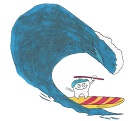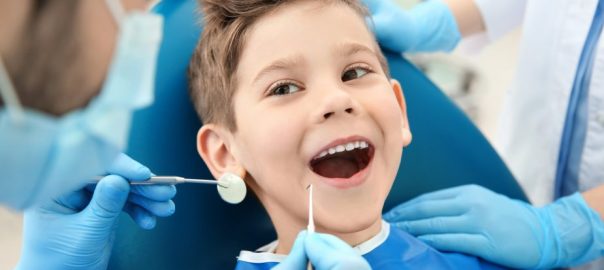Dental anxiety is prevalent among children. It has been found that as many as 19.5% of school-age children are afraid of dentists. Treating a child with dental anxiety presents a challenge to the dental clinician. In fact, it has been reported that dentists consider the fearful child to be among the most problematic types of patients. Dental anxiety is not only problematic for the clinician, but it also has potentially detrimental effects on the patient when it interferes with receiving optimal dental care. What follows are several behavioral strategies that should prove helpful in managing a child with dental anxiety.
INFORMATION
In general, children tend to do best when their life is predictable. They are more likely to tolerate a procedure when they have been told in advance what to expect. Providing information is particularly important in the case of an anxious child. The clinician should consider describing what he or she will be doing and what sensations the child will experience (eg, what type of noise he or she will hear, what type of vibrations he or she will feel, what it will taste like). Young children may have difficulty understanding complicated verbal explanations; for them, demonstration or role-play can be a useful strategy. The tell-show-do method, described by Addelston in 1959, is commonly suggested in the child focused general dentistry literature. Specifically, the clinician (1) tells the child what will happen in developmentally appropriate language; (2) shows the child how the procedure will work on himself or herself or on a model; and (3) follows through with the procedure once it is clear that the child understands what is about to occur.
RELAXATION
For the child who is visibly anxious or reports feeling anxious to the clinician, relaxation strategies are quite useful. Many children will experience relief following a simple deep-breathing exercise, which involves deep inhalation and slow exhalation. Asking the child to blow bubbles through a wand (the type bought commercially during summer months) produces a similar effect and sometimes provides distraction as well. Another somewhat more time-consuming approach involves progressive muscle relaxation. Specifically, the child systematically tenses and relaxes each muscle group in the body. The child reclines in the dental chair with arms by his or her side and eyes closed. The child is then asked to tense and relax each group of muscles in sequence, starting from the right toes and progressing to include the right heel, ankle, calf, knee, thigh, and hip. The child then repeats the exercise on the left side of the body. The right and left arm are then tensed and relaxed, followed by the shoulders, neck, jaws, cheeks, forehead, eyes, and scalp. Finally, the child is asked to focus on or her breaking and relaxing the muscles in the chest and abdomen. Audiotapes to guide this procedure are commercially available.
DISTRACTION
Distraction can be useful in minimizing dental anxiety. There are several methods of distraction for the clinician to consider. First, if the child is playing with a toy in the waiting room, it is possible that the toy could also serve to distract the child from the dental chair. Obviously, not all toys or procedures are amenable to this strategy, but it should at least be considered. Further, simple dialogue with the clinician may serve to distract a child. Initially, the clinician can attempt to engage the child in a discussion about a pleasant topic. This will not only distract the child but will also serve to build rapport. However, once a procedure is initiated, the child will be unable to participate in the conversation.
Another form of distraction is visualization. Specifically, the clinician can ask the patient to visualize a pleasant experience, such as a recent birthday party or a trip to an amusement park. For this strategy to be effective, the child must really feel as though he or she is re-experiencing a particular event. To do so, the clinician may need to provide prompts, such as asking the child to think about the particulars of the setting. Further, attention distraction can be a useful strategy. Giving a child a task such as counting the ceiling tiles or doing mental arithmetic can serve to shift the focus away from the procedure at hand. Finally, television, videotapes, and video games are terrific distracters. Clinicians using such props should be sure to have a wide selection for their patients, as these distracters will be effective only if they are interesting to the child.
REINFORCEMENT
Positive reinforcement in terms of praise and small, tangible rewards (eg. stickers, pretend tattoos, baseball cards) can be useful incentives for cooperation and for “brave behavior.” Reinforcements can be issued frequently, with younger children requiring more frequent reinforcement than older children. There is really no such thing as too much reinforcement, although the clinician should attempt to be genuine. If a child is particularly challenging, the clinician might consider providing the child with a token every few minutes if he or she is cooperative (of course, it would be important to explain to the child at the outset exactly what is expected of him or her). At the end of the appointment, the child could be given the opportunity to cash in his or her tokens for a small treat from the dental office or from the parent. The clinician should be sure that the incentive being offered is something that the child really values and will work toward, otherwise, this strategy will be ineffective. It might be useful to create a “treasure chest” filled with a variety of small, tangible rewards that would appeal to both boys and girls of a variety of developmental levels. Feel free to consult with a parent about what reinforcers might be effective with a particular child and don’t hesitate to ask a parent to bring reinforcements to the dental office to be used during the appointment.
PARENTAL INVOLVEMENT
There are several ways in which parental involvement can be helpful in dealing with anxious children. First, if a child is experiencing a significant level of distress, the clinician should not hesitate to ask the parent for assistance. It is likely that the child has exhibited such anxiety in other contexts, and the child’s parent likely has some strategies that may be most effective with the child. On another note, while the issue of parental presence during stressful medical procedures is somewhat controversial, some children certainly will feel more reassured with their parents sitting by their side. Hence, just having the parent in the office may relieve anxiety in some child patients, and this strategy is worth consideration. Finally, it is important to consider the role of parents as models for their children. If it is possible for the clinician to model a procedure on a parent, the child will not only obtain information about what to expect from the procedure, but the parent, who is likely a very salient model for the child, is able to demonstrate for the child his or her expected behavior during the procedure.
CONCLUSION
The use of the management strategies described in this article will increase the likelihood that dental appointments will go smoothly and will ultimately be completed. In dealing with a child with dental anxiety, it is extremely important to complete the treatment. Treatment completion not only has implications for the patient’s health but will also allow the child to realize that the procedure was not nearly as aversive as had been expected. This sense of mastery will likely enable the child to confront future dental appointments with less anxiety. Given the prevalence of dental anxiety, as well as its implications, it is important to consider a broad range of management strategies that can easily be implemented in the dental setting.
Here at Carlsbad Pediatric Dental, we do all we can to ensure all of our patients have a great dental experience. Dr. Marta has been trained in ways to alleviate and reduce anxiety in her patients. Call us today at (760) 434-7374 to schedule your family’s next dental appointment.




